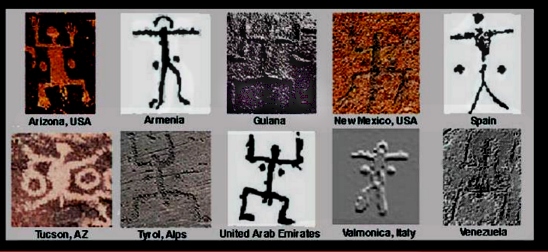Anthropology
Related: About this forumTed Talk: Why are these 32 symbols found in ancient caves all over Europe?
From the talk
Over the course of two years, my faithful husband Dylan and I each spent over 300 hours underground,hiking, crawling and wriggling around 52 sites in France, Spain, Portugal and Sicily. And it was totally worth it. We found new, undocumented geometric signs at 75 percent of the sites we visited. This is the level of accuracy I knew I was going to need if I wanted to start answering those larger questions.
So let’s get to those answers. Barring a handful of outliers, there are only 32 geometric signs. Only 32 signs across a 30,000-year time span and the entire continent of Europe. That is a very small number.Now, if these were random doodles or decorations, we would expect to see a lot more variation, but instead what we find are the same signs repeating across both space and time. Some signs start out strong, before losing popularity and vanishing, while other signs are later inventions. But 65 percent of those signs stayed in use during that entire time period — things like lines, rectangles triangles, ovals and circles like we see here from the end of the Ice Age, at a 10,000-year-old site high in the Pyrenees Mountains. And while certain signs span thousands of kilometers, other signs had much more restricted distribution patterns, with some being limited to a single territory, like we see here with these divided rectangles that are only found in northern Spain, and which some researchers have speculated could be some sort of family or clan signs.
On a side note, there is surprising degree of similarity in the earliest rock art found all the way from France and Spain to Indonesia and Australia. With many of the same signs appearing in such far-flung places, especially in that 30,000 to 40,000-year range, it’s starting to seem increasingly likely that this invention actually traces back to a common point of origin in Africa. But that I’m afraid, is a subject for a future talk.
So back to the matter at hand. There could be no doubt that these signs were meaningful to their creators, like these 25,000-year-old bas-relief sculptures from La Roque de Venasque in France. We might not know what they meant, but the people of the time certainly did. The repetition of the same signs, for so long, and at so many sites tells us that the artists were making intentional choices. If we’re talking about geometric shapes, with specific, culturally recognized, agreed-upon meanings, than we could very well be looking at one of the oldest systems of graphic communication in the world.
I’m not talking about writing yet. There’s just not enough characters at this point to have represented all of the words in the spoken language, something which is a requirement for a full writing system. Nor do we see the signs repeating regularly enough to suggest that they were some sort of alphabet. But what we do have are some intriguing one-offs, like this panel from La Pasiega in Spain, known as “The Inscription,” with its symmetrical markings on the left, possible stylized representations of hands in the middle, and what looks a bit like a bracket on the right.
On a side note, there is surprising degree of similarity in the earliest rock art found all the way from France and Spain to Indonesia and Australia. With many of the same signs appearing in such far-flung places, especially in that 30,000 to 40,000-year range, it’s starting to seem increasingly likely that this invention actually traces back to a common point of origin in Africa. But that I’m afraid, is a subject for a future talk.
TreasonousBastard
(43,049 posts)Ichingcarpenter
(36,988 posts)Notice the two globes, left and right of the body

TreasonousBastard
(43,049 posts)another ancient symbol found worldwide. Now the swastika makes more sense (at least the ancient one does-- not the Nazi one)
Any theories on what the globes/dots are? My first thought was breasts, but there's male genitalia shown.
Ichingcarpenter
(36,988 posts)the squatting man is something they saw in the sky, not a Ufo , but a real phenomenon such as a really bad solar outburst, a plasma outburst of unimaginable intensity and consequences
Interesting supposition anyway.
Judi Lynn
(162,815 posts)Response to Ichingcarpenter (Original post)
Name removed Message auto-removed